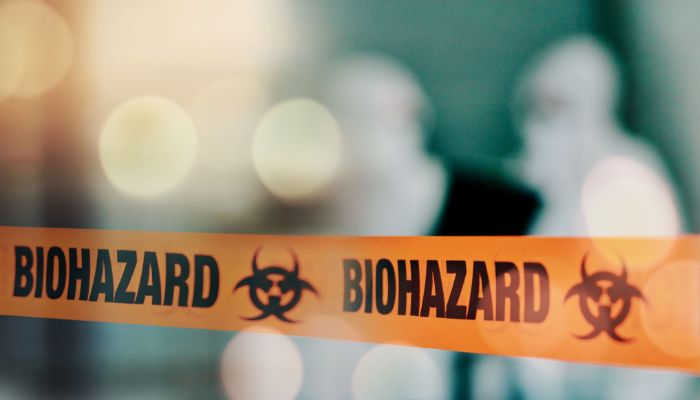In a world where unforeseen disasters can strike at any moment, it’s crucial to be prepared not only for natural calamities but also for biohazards that may endanger your home or workplace.
From mold and bacteria to viruses and other organic contaminants, biological agents can jeopardize health, safety, and property value if left unchecked.
At PuroClean of Evanston, we understand the importance of proactive measures to prevent biohazards from wreaking havoc in your living or working space. Let’s delve into some practical steps you can take to safeguard your home or workplace against a biohazard threat.
Know Your Environment
The term “biohazard” encompasses a broad range of substances or organisms that pose a threat to human health. These hazards can manifest in various forms, including infectious pathogens, toxins, or contaminated materials. Common examples of biohazards include bacteria, viruses, mold, and bodily fluids.
The first step in biohazard prevention is understanding the specific risks associated with your house or office. It’s smart to conduct a comprehensive risk assessment to identify potential sources of trouble.
Moisture, warmth, and darkness — this trifecta of conditions allows biohazards like mold to thrive. Areas at higher risk include bathrooms, basements, crawl spaces, and anywhere leaks or flooding can occur.
Kitchens also require vigilance due to spills and food waste. At commercial properties, pay special attention to HVAC systems, ceiling tiles, carpets, and anywhere moisture accumulates. Stopping moisture issues before they start is critical for preventing problems like a toxic mold outbreak.
During your risk assessment, consider factors such as the location, industry, and activities conducted on the premises. This report will serve as the foundation for your prevention strategy, and will also help you determine if you have the appropriate insurance coverage.
Your Frontline Defense
Construction and maintenance choices significantly impact biohazard development. During new builds or renovations, choose mold-resistant building materials such as tile, metal, plaster, and concrete over more hospitable materials like drywall and wood.
Install exhaust fans in kitchens, bathrooms, and laundry rooms to efficiently vent moisture. Use vapor barriers and insulation techniques that deter moisture accumulation within walls or attics. Perform regular inspections and repairs to quickly address any leaks or water intrusion issues.
Indoor air quality directly affects biological growth. To discourage contamination, follow a regular cleaning routine using disinfectants to kill bacteria and viruses.
Keep humidity under 50% by using dehumidifiers and fans. Maintain temperatures between 68-78°F — overly warm or cold conditions can accelerate issues. You can increase the circulation of fresh air by opening windows when possible. Consider air purification systems with HEPA filters to trap airborne particles.
Maintaining a clean and sanitary environment is one of the most effective ways to prevent biohazards. Establishing cleaning protocols that include the use of disinfectants will help prevent the spread of infectious diseases and inhibit the growth of mold or mildew.
Remediating Threats
Even with preventative steps, biohazards can emerge. Events such as accidents, flooding, plumbing backups, or extreme weather happen all the time and can expose a building’s inhabitants to potentially lethal substances.
It’s vital to conduct periodic and thorough visual inspections of your residence or business, checking all surfaces for mold growth, moisture, or musty odors. Target humid areas like behind sinks, under carpets, or around pipes.
Don’t forget seldom-used spaces like attics, basements, or spare rooms. If mold or bacteria is detected, take swab samples to identify the exact species through lab testing so you know exactly what you’re dealing with.
Major moisture events demand an immediate response to avoid severe, embedded biohazard growth. If a flood, leak, or sewage backup occurs, wear protective equipment and remove excess water as soon as possible.
Employ subfloor drying techniques like dehumidifiers, air movers, and moisture traps to dry all affected areas within 24-48 hours. Discard unsalvageable porous materials that may foster mold growth, and you should schedule a professional mold inspection if contamination is suspected. Prompt action will help you minimize damage and health risks.
While very minor issues can be dealt with DIY-style, it’s always best to partner with an experienced remediation team, who will be able to rapidly execute plans involving protective gear, specialized biocides, structural repairs, and contamination removal techniques.
In workplaces, biohazard outbreaks can force closures, disrupt operations, and result in loss of productivity. Failure to address these problems adequately can result in costly legal liabilities, medical expenses, and regulatory fines.
Disaster comes in many forms, and residential and commercial property owners and managers should definitely have an emergency response plan in place that includes SOPs for biohazard occurrences.
Left unchecked, these types of hazards can seriously endanger your health and cause structural deterioration. However, following proactive maintenance practices, vigilant monitoring, and swift remediation when issues arise can help protect your home or business.
Contact PuroClean of Evanston today for professional inspections, containment, and elimination services to safeguard your property from these invisible threats!




 PuroClean of Evanston
PuroClean of Evanston